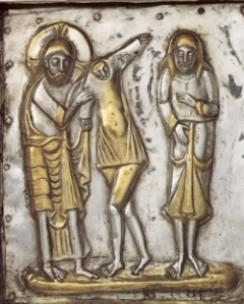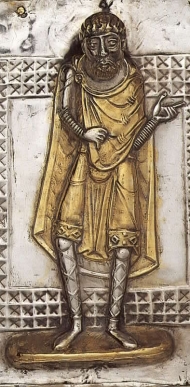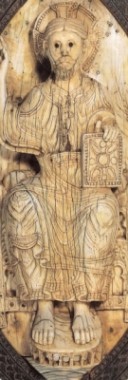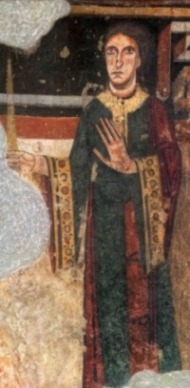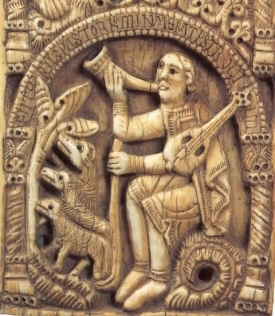| |
| |
| |
| Detail from the Parable of the Careful
Virgins, Iglesia de Sant Quirze de Pedret (Bergueda)
c.1100 Musuem of Catalan Art, Barcelona
|
| |
| Mozarabic Spain, that area under Muslim domination,
developed styles of dress distinct from those of the rest of Christian
Europe. Unlike the previous period, there is more evidence in miniatures
as to styles for this period of Spanish history. Bernis first mentions
the camisa, but does not explain the nature of this garment,
except for the mention of camisas lineas (linen) and camisas
siricas (silk) and the fact that these were white and other colors.
There is, however, more information on tnicas. In Spain, unlike the rest
of Europe, these were seen in great variety and many had names of Arabic
origin. The mutebag was tight and sleeveless while the mofarage
or mofarrex was split and open from the waist, leaving the legs
bare. |
| |
The Roda Bible (cat.158, fol.66r) Biblioteque
Nationale, Paris
Scenes from the Book of Daniel.11th |
|
| The upper class wore tunicas in
different lengths which were worn over each other (and outer tunics were
called pintelles, or aljubas, a term that is used in
succeeding centuries to designate an outer garment. There is also reference
to the adorra, which was buttoned down the front, probably the
earliest reference to buttons. There are also seen tnicas that are open
in front to an inverted point, those that are lengthened in back to the
ankles (sometimes in points) and those with a rectangular train in the
back. Tunicas were made of wool and linen and, in the Kingdom
of Leones, they were seen in expensive colored silk. (Muslim Spain at
this time was in competition with the Orient in the manufacturing of silk
fabrics.) Garments were decorated with strips (possibly of embroidery)
on the cuffs, sleeves, and shoulders, and a single garment could be made
of several different colors of cloth. Fabric was decorated with small
overall patterns, especially groups of three dots, and also with larger
patterned stripes. |
| |
Left: Robing of Adam and Eve. Reliquary of Saint Isidore.
1063 or earlier. Real Colegiata de San Isidoro, León
Right: Ferdinand I (?). Reliquary of Saint Isidore. 1063
or earlier.
Real Colegiata de San Isidoro, León |
|
| |
Left: Monastery of San Millán del
a Cagolla (Legroña) . 1060-1080. Dumbarton Oaks, Washington, D.C.
Right: Abiside, in the Iglesia de
Stan Pere de Bugal, Lérida
end of 11th century
Museum of Catalan Art, Barcelona |
|
| Mantles also developed a great variety
and were mobatana (fur-lined), barragan (wool), and
alifafe (made of different furs). Common furs were weasel, rabbit,
and lamb. A peculiarly Spanish style, probably originating from the Roman
paenula, was completely closed, was shorter in the back than in the front,
and had a band decorating the lower front edge. Another traditionally
Spanish style, worn by both men and women, is one that had an opening
for the left arm. Also still seen is the short Visigothic cape. |

Beato. Catedral de Burgo de Osma
|
Masculine Spanish fashion is distinguished by garments
for the legs, especially loose-fitting pants gathered at the ankles, seen
in pictures of knights and other important figures; a shorter version
of these are worn by the lower class. These pants could possibly be descendants
of the Visigothic femaralis, or might show Muslim influences. |
| Most names for footwear do show this influence,
such as ballugas, which rose up around the ankles, and soccos,
albacas, and zapatones. (Zapatas came to be one
of the generic name for footwear through the Renaissance.) There are also
mentioned sandalia, obviously from the Romans, and we see shoes
with curled pointed toes, showing Arabic influence. |
 |
Left: King Ramiro and a Companion (plaque
from a reliquary of Saint Aemilian) 1060-80.
Monastery of San Millán del a Cagolla (Legroña) . State
Hermitage Musuem,
Saint Petersburg
Right:Monastery of San Millán de la Cagolla (Legroña)
. 1060-1080.
|
|
Various types of headwear are shown in miniatures,
from the tall, pointed mitres of the bishops to the semi-circular, crested
silhouetted of the king. Also seen is the tall, round headwear of the
upper class and the pointed helmet (?) of the soldier. Turbans are also
evidenced, and this could explain what looks like a disc around the heads
of some figures. Also described is a hood that covers the head and neck,
held to either with a large band called an almaizar. |
11th Century Image Gallery
Home |




